12 Best Mastiff Breeds to Add to the Family
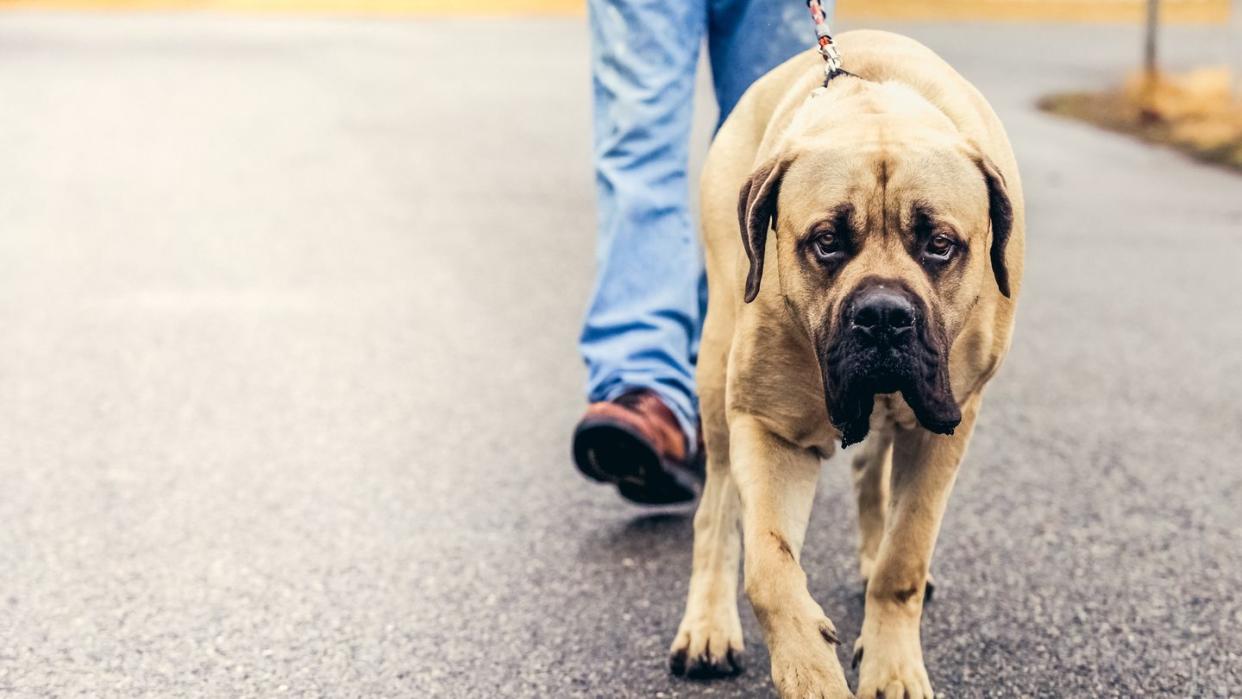
If you think about it, you can divide dog lovers into two groups: those who prefer cute and cuddly small dogs, and those who are partial to strong and stately big dogs. Sure, all dogs are wonderful, but if you tend to favor the latter rather than the former, you going to want to check out our rundown of the best mastiff breeds. We've included everything from the noble Neopolitan mastiff to the famous French mastiff, and, of course, the popular English mastiff. Because when you're talking large and in charge poochies, there are few bigger than the magnificent mastiff. Best of all, the members of this breed tend to share traits that make them great pets for families, including intelligence, trainability and incredibly affectionate and even empathetic natures. And of course, there may be no better guard dog than a mastiff.
That's not to say all mastiff breeds are right for all pet parents. Due to their size, which is sometimes combined with an inclination toward wariness around strangers, "Mastiffs require early socialization and consistent training," says Dr. Kathryn Dench, veterinarian and chief scientific advisor for Paw Origins. Mastiffs also need "regular veterinary care to manage common health issues like hip dysplasia, bloat and cardiac problems," she adds. "In my clinical experience, around 25-30% of mastiffs are affected by hip dysplasia, highlighting the importance of regular health screenings and maintaining a healthy weight."
To get the straight scoop on mastiff breeds we checked in with not only Dr. Dench but also her fellow vets Dr. Jenna Dockweiler, veterinary geneticist at Embark Veterinary, and Dr. Iram Gladan, who contributes to Breed Atlas. Below, you find everything you need to know so you can best choose your next four-legged friend—ideally from a shelter or mastiff rescue organization.
More for potential dog parents:
Bullmastiff
A cross between the bulldog and the Mastiff, the bullmastiff is a faithful, courageous, and loving companion. He's perky but protective of his people (as pretty much all mastiffs are), and enjoys daily exercise—though probably less of a run than simply a good walk. The breed is easy to care for in other ways, too, with a red-, brindle- or fawn-colored coat that doesn't shed much.
Based on his history alone, the bullmastiff should make for an excellent—and relatively gentle—watchdog. "This breed was developed in England during the 19th century to guard estates," Dr. Dockweiler says. "It was bred not to injure trespassers; instead, it used its enormous size to pin down its target."
Height: 25-27 inches
Weight: 110-130 pounds
Life Expectancy: 7-9 years
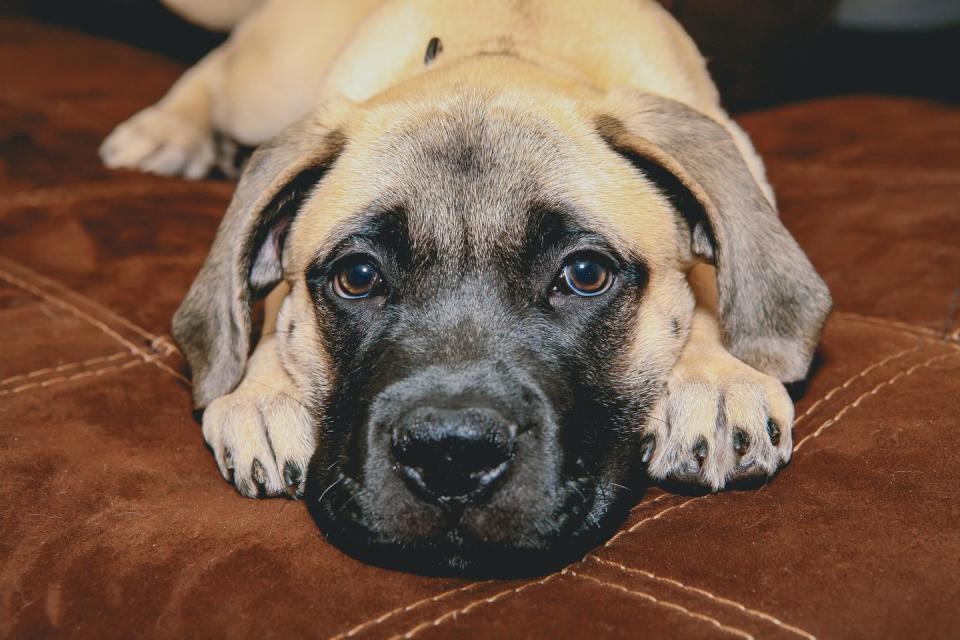
Neopolitan Mastiff
Easily distinguished by the loose folds of skin and heavy wrinkles that droop from their noble faces, the mastino Napoletano (as they're known in their native Italy) may date back to as early as 700 B.C. "They used to be war dogs and the protectors of the house," Dr. Gladan says. "They're very loyal, protective, and devoted to their family, and can be reserved or wary around strangers, making them excellent guard dogs."
Though short-coated, this heavily built and dignified fellow overheats easily, so be sure to keep a close eye on him in hot weather. Make sure you also give plenty of attention to those facial folds, keeping them clean and dry to prevent skin issues.
Height: 26-31 inches
Weight: 150 pounds
Life Expectancy: 7-9 years

Tibetan Mastiff
So ancient he's believed to be the breed from which all other mastiffs originated, this massive but mellow pooch hails from the Himalayan region of Tibet. One of his most stunning physical features is his impressive double coat, well-suited for keeping the Tibetan mastiff warm in the frigid alpine conditions of his native land. But despite its thickness, this breed only needs weekly brushing through most of the year.
According to Dr. Gladan, the Tibetan mastiff is "strong-willed, independent, and very protective. They can be loyal to family but aloof with strangers." Their reserved and rather territorial nature with people they don't know, as well as their keen intelligence, mean these canines are typically extremely well-suited to defending hearth and home.
Height: minimum 26 inches
Weight: 90-150 pounds
Life Expectancy: 10-12 years
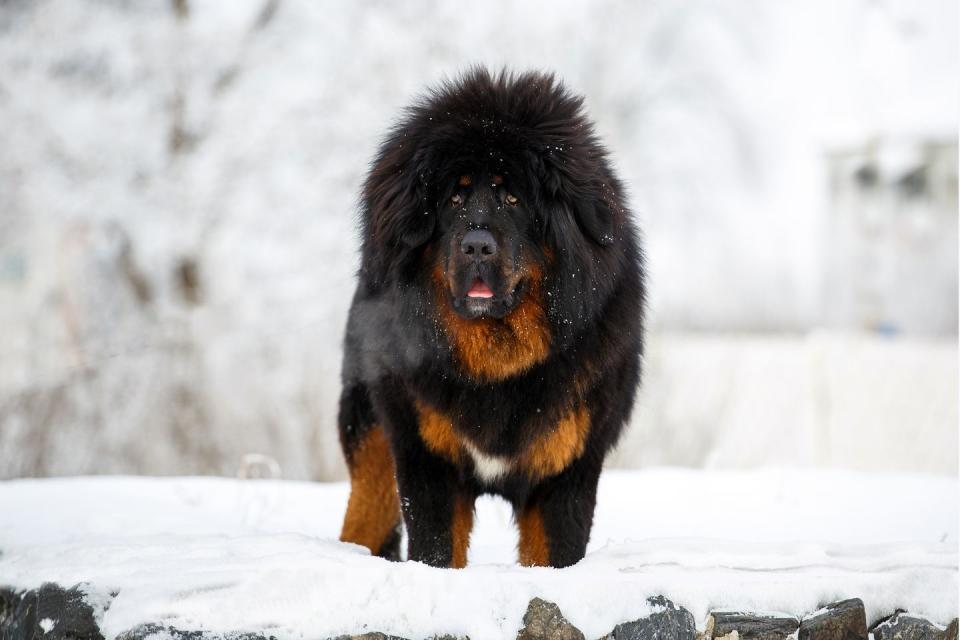
Spanish Mastiff
This doggo routinely tangled with wolves during the Middle Ages, when he protected livestock in Spanish pastures for itinerant sheepherders. With his working dog heritage, the Spanish mastiff needs daily exercise, which can include several walks a day, backyard play, or activities like swimming and hiking. Smart as a whip, he's also a good fit for dog sports training.
Dubbed kind and affectionate by the American Kennel Club, this breed has adapted to domesticity beautifully. "Known for their calm and gentle demeanor, Spanish mastiffs are excellent family dogs," Dr. Dench says. "They're patient and loyal, and particularly good with children." However, they're a bit barky, with a deep, powerful voice, so they might not be the best choice for apartment living.
Height: minimum 28-35 inches
Weight: 140-200 pounds
Life Expectancy: 10-12 years
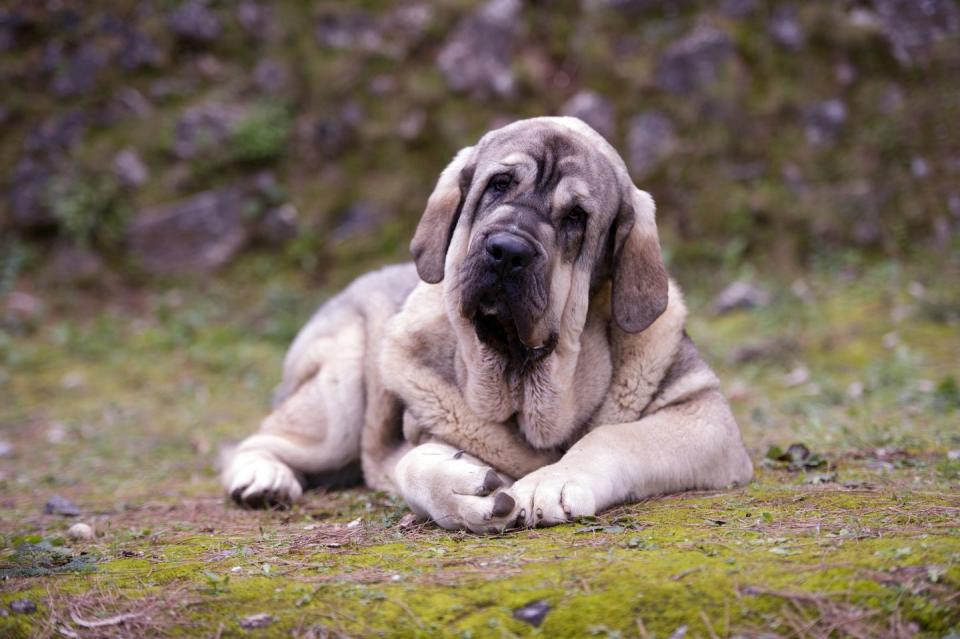
English Mastiff
Also known as simply the Mastiff, this mammoth fellow is the largest dog by weight. He's also so old that Julius Caesar's forces fought against the breed when the Roman emperor invaded Britain. Nowadays, the Mastiff is a wonderfully patient pooch and makes an ideal pet for families with young children. He's also low-key enough that he can live happily in an apartment!
"For the most part, they are not very energetic dogs," notes Dr. Gladan, "so they like to just lie around. But they do need a fair amount of exercise to stay in good health." Daily walks of a mile or two should do it for an adult Mastiff; you can get away with brushing him a couple of times a week, but be prepared for lots and lots of drooling.
Height: 30 inches and up
Weight: 160-230 pounds
Life Expectancy: 6-10 years
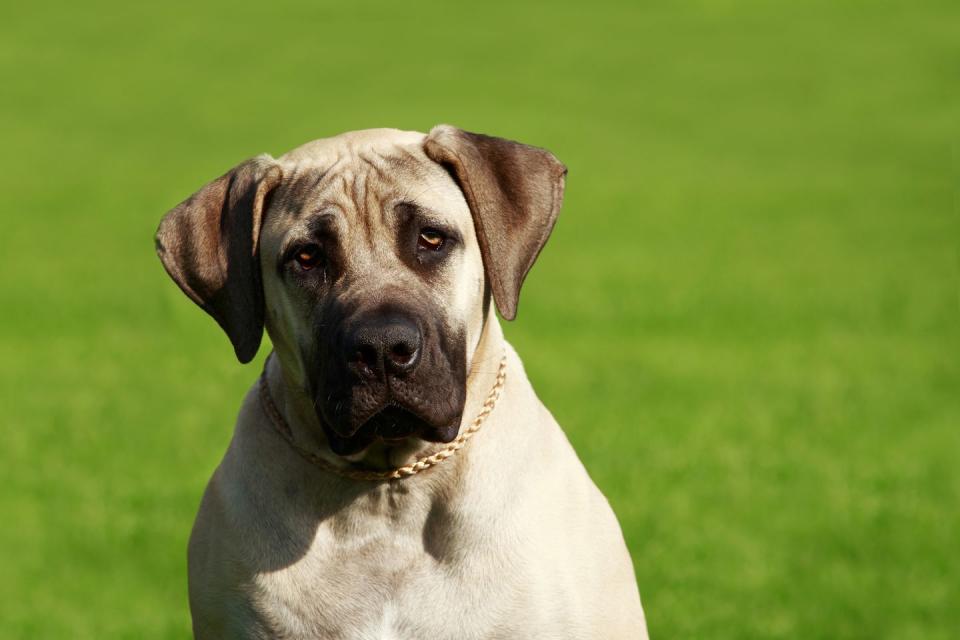
Brazilian Mastiff
One of the rarer breeds of mastiffs, the Brazilian mastiff, or fila Brasileiro, isn't currently recognized by the AKC. The dog is thought to be a mix of Mastiff and bloodhound, though its exact lineage is unknown. What is certain is that it was developed centuries ago in the South American country from which it takes its name to hunt wildlife (including jaguars!) and protect farms and livestock.
To this day, these dogs still "have strong guarding instincts and are known for their ability to track and apprehend," says Dr. Gladan. "They love their family but are very suspicious of strangers; sometimes, they are quite aggressive." For these reasons, these athletic, energetic and sometimes stubborn canines are best left to seasoned dog parents with larger rural properties.
Height: 26 to 30 inches
Weight: 140 to 180 pounds
Life Expectancy: 9 to 11 years
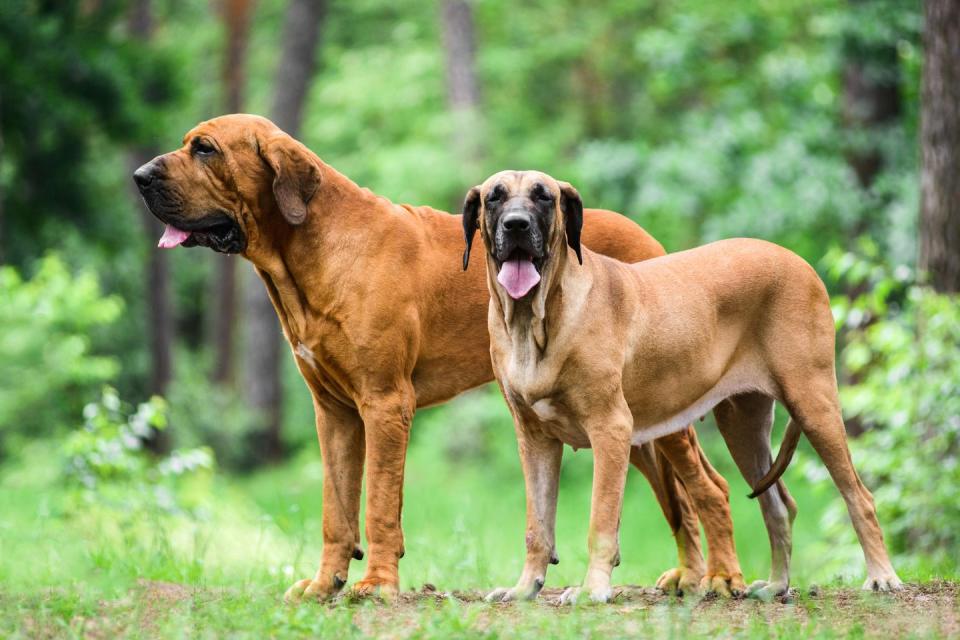
French Mastiff
With a pedigree so old no one knows his exact origin story, the French mastiff may be a mix of one or another mastiff breed and a bulldog, according to Dr. Dockweiler. "They are large in stature with an undershot jaw, she says. "Proportionally, they have the largest head in all of caninedom. Because of these features, they tend to drool excessively!" Along with wiping up slobber, be prepared to spend some time keeping this breed's wrinkles clean and dry.
Made famous by his co-starring role in the old Tom Hanks movie Turner and Hooch, the dogue de Bordeaux (as he's called in his native France) has been a fighter, a hunter, a guarder and a drover during the course of his long history. These days, thanks to his remarkably sweet and sensitive temperament, he's best known for being one of the most cuddlesome of all mastiffs.
Height: 23-27 inches
Weight: 110 pounds and up
Life Expectancy: 5-8 years
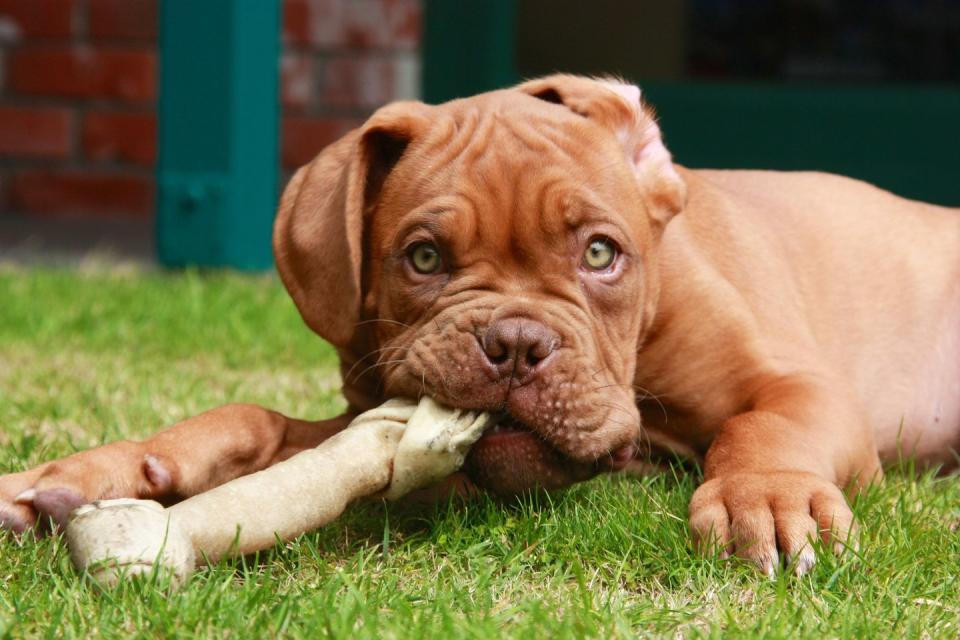
Cane Corso
An undeniably regal dog, the cane corso (or Italian mastiff) is famously cool, confident, and clever—the James Bond of the canine world. Likely descended from Roman war dogs, the breed was "bred in Italy to function as a guard dog and to hunt large game while also fulfilling general farmland tasks," says Dr. Dockweiler. "Although they first entered the USA in the late 80s, this breed wasn’t officially recognized by the AKC until 2010."
Smart, strong, and assertive, the cane corso is a wonderful family pet due to his easygoing and affectionate personality. But be aware he requires mental and physical stimulation lest he begin acting out from boredom and frustration. Twice daily short runs (or, at least, very brisk walks), are needed to keep this breed happy.
Height: 25-27.5 inches
Weight: proportionate to height
Life Expectancy: 9-12 years
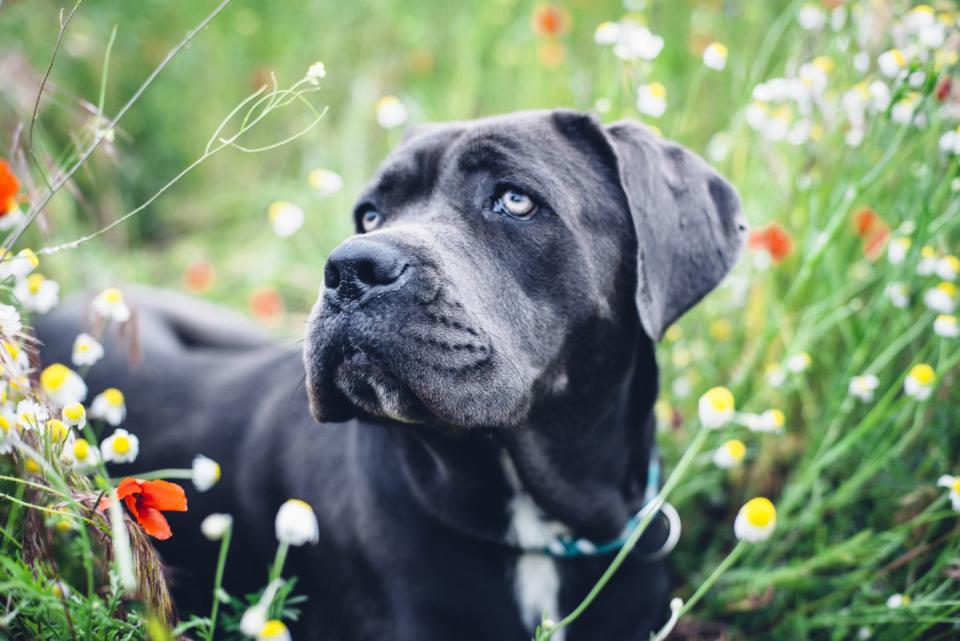
South African Mastiff
When a dog was bred to routinely do battle with leopards and lions, you know he's got to be tough. And so it is with the South African mastiff or boerboel. Used by farmers to guard their homestead from large predators, this breed is surprisingly agile for its size and very, very strong. The South African mastiff requires significant exercise, but with his pugnacious background and domineering personality, this is not the pup to take to the dog park or allow to run off-leash.
However, an experienced pet parent will discover boerboels to be both "confident and intelligent," says Dr. Dench. "They're known for their protective nature and make excellent guard dogs, but they're also good with families, showing patience and loyalty."
Height: 24-27 inches
Weight: 150-200 pounds
Life Expectancy: 9-11 years
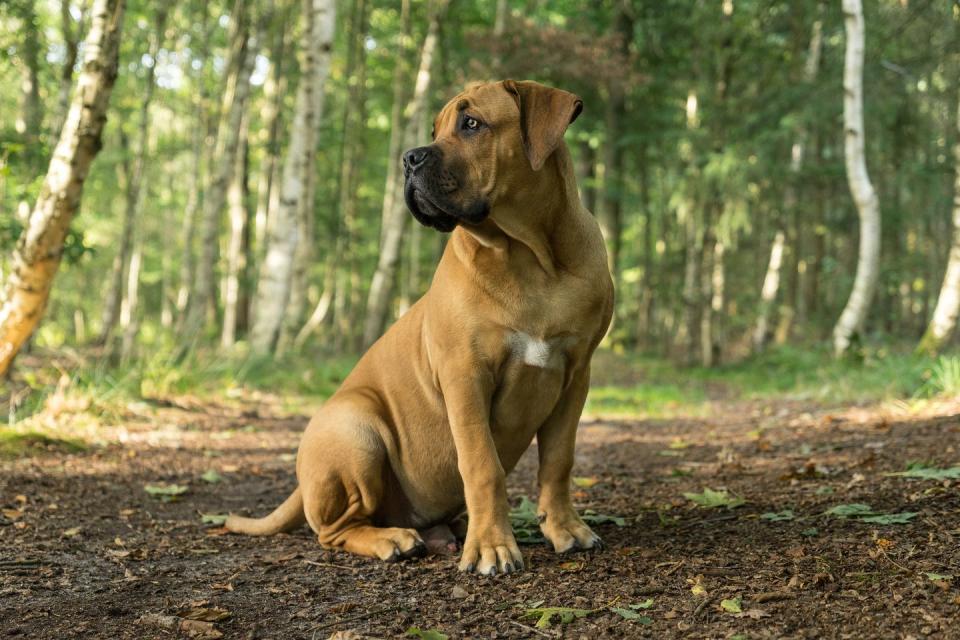
Pyrenean Mastiff
This rare Spanish mountain dog, which dates back some 3,000 years, counts as its close cousins the Spanish mastiff and the Great Pyrenees. Like those breeds, the Pyrenean mastiff was a livestock guardian and still retains his independent personality. Notoriously good with young children and other dogs, this breed is gentle, kind and loving, according to Dr. Dockweiler.
However, she adds, "This large breed takes its work seriously and needs an assertive and experienced owner. It should be socialized from puppyhood to encourage confidence, but it may always be in its nature to remain suspicious of strangers. Common behavior problems include excessive barking and resource guarding, though both can be managed with appropriate training."
Height: 30-31 inches
Weight: 120-190 pounds
Life Expectancy: 10-12 years

Argentinian Mastiff
With his showy, all-white coat, powerful build and typically cropped ears, the Argentinan mastiff is a dog that makes a statement wherever he goes. According to Dr. Dockweiler, the breed was developed in 1928, "by Dr. Antonio Nores Martinez in the Cordoba province of Argentina. He mixed several breeds, including great Danes, boxers, bull terriers, Irish wolfhounds, and pointers, with the fierce old fighting dog of Cordoba."
The result was the dogo Argentino, a canine that quickly proved adept at big game hunting, pursuing everything from wild boars to pumas with deadly skill. In the home, they are remarkably affectionate with their humans and surprisingly welcoming to strangers. However, like the boerboel, this mastiff has a strong prey drive and shouldn't mix with smaller pets. And, as with other white animals (like Persian cats), the breed is genetically predisposed to deafness.
Height: 24-26.5 inches
Weight: 80-100 pounds
Life expectancy: 9-15 years
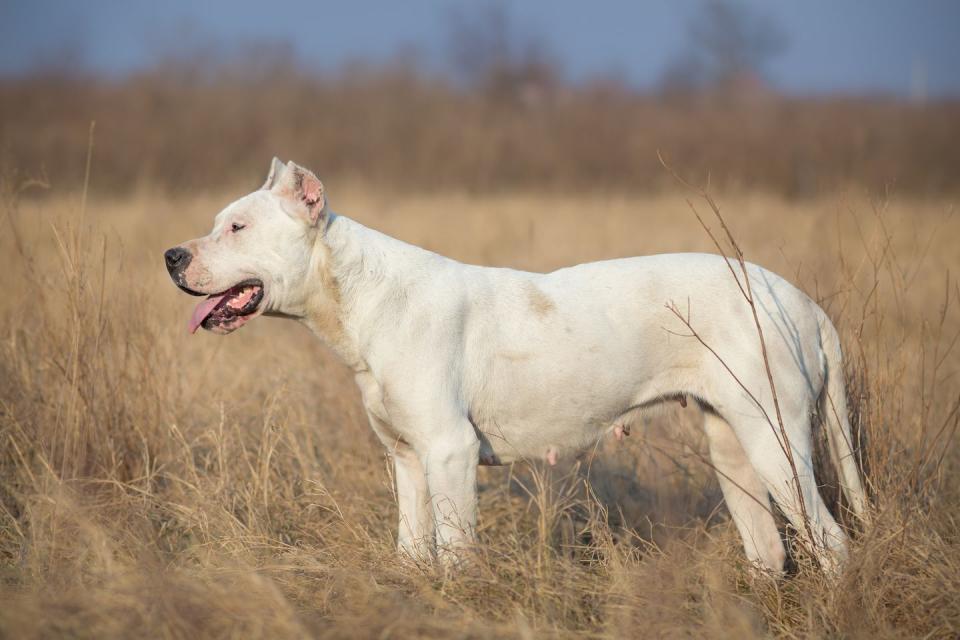
Japanese Mastiff
Believed to be a mix of Shikoku inu, bulldog, Mastiff, great Dane and German pointer—with perhaps a bit of bull terrier and Saint Bernard thrown in for good measure—this breed's roots date to around the mid-19th century. "Originating in Japan, they were bred for dog fighting and are still used in traditional dog fighting in Japan," Dr. Dench says. Also called Tosa inus and simply Tosas, "They are known for their bravery and loyalty," she adds.
Extremely loving with family, this breed is usually calm and composed, even serene. However, the Japanese mastiff is cautious around strangers and, due to his sad history, potentially aggressive with other canines. His vigilant disposition means he's a great watchdog, but he probably needs to be the only pet in the household.
Height: Minimum 21.5-23.5 inches
Weight: 100-200 pounds
Life Expectancy: 10-12 years
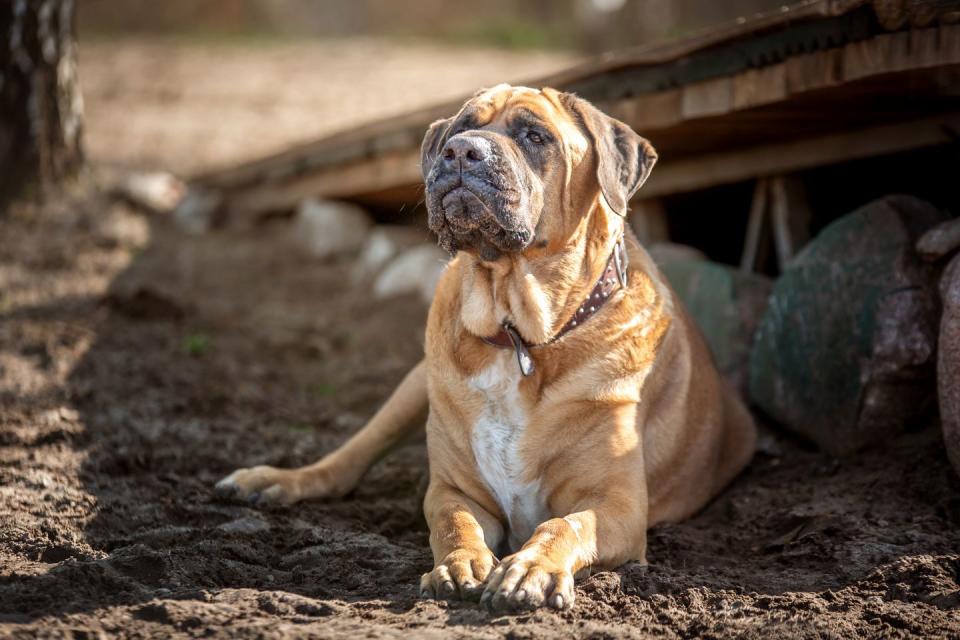
You Might Also Like


